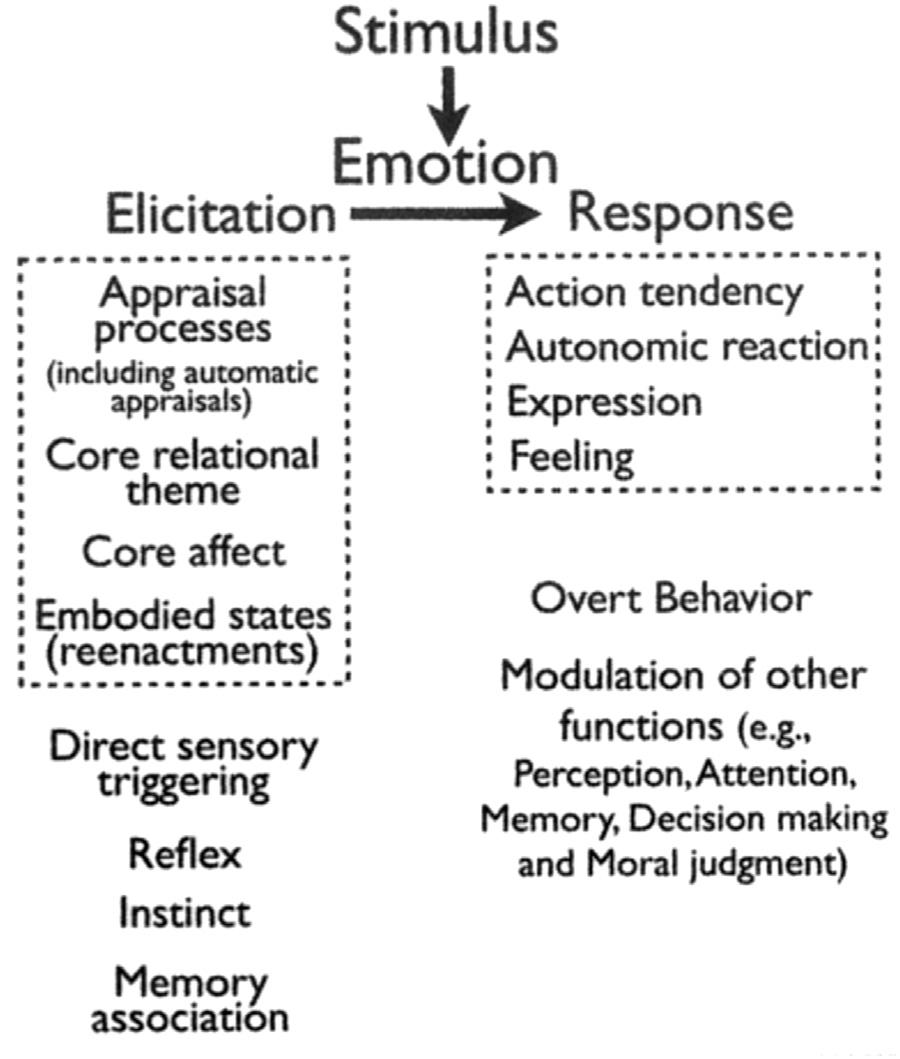EmotionMeasurement
SecondEdition
Editedby HerbertL.Meiselman
WoodheadPublishingisanimprintofElsevier
TheOfficers ’ MessBusinessCentre,RoystonRoad,Duxford,CB224QH,UnitedKingdom 50HampshireStreet,5thFloor,Cambridge,MA02139,UnitedStates TheBoulevard,LangfordLane,Kidlington,OX51GB,UnitedKingdom
Copyright 2021ElsevierLtd.Allrightsreserved.
Nopartofthispublicationmaybereproducedortransmittedinanyformorbyanymeans, electronicormechanical,includingphotocopying,recording,oranyinformationstorage andretrievalsystem,withoutpermissioninwritingfromthepublisher.Detailsonhowto seekpermission,furtherinformationaboutthePublisher’spermissionspoliciesandour arrangementswithorganizationssuchastheCopyrightClearanceCenterandtheCopyright LicensingAgency,canbefoundatourwebsite: www.elsevier.com/permissions .
Thisbookandtheindividualcontributionscontainedinitareprotectedundercopyrightby thePublisher(otherthanasmaybenotedherein).
Notices
Knowledgeandbestpracticeinthis fieldareconstantlychanging.Asnewresearchand experiencebroadenourunderstanding,changesinresearchmethods,professional practices,ormedicaltreatmentmaybecomenecessary.
Practitionersandresearchersmustalwaysrelyontheirownexperienceandknowledgein evaluatingandusinganyinformation,methods,compounds,orexperimentsdescribed herein.Inusingsuchinformationormethodstheyshouldbemindfuloftheirownsafety andthesafetyofothers,includingpartiesforwhomtheyhaveaprofessionalresponsibility.
Tothefullestextentofthelaw,neitherthePublishernortheauthors,contributors,or editors,assumeanyliabilityforanyinjuryand/ordamagetopersonsorpropertyasamatter ofproductsliability,negligenceorotherwise,orfromanyuseoroperationofanymethods, products,instructions,orideascontainedinthematerialherein.
LibraryofCongressCataloging-in-PublicationData
AcatalogrecordforthisbookisavailablefromtheLibraryofCongress
BritishLibraryCataloguing-in-PublicationData
AcataloguerecordforthisbookisavailablefromtheBritishLibrary
ISBN:978-0-12-821125-0
ForinformationonallWoodheadPublishingpublicationsvisitour websiteat https://www.elsevier.com/books-and-journals
Publisher: CharlotteCockle
AcquisitionsEditor: MeganR.Ball
EditorialProjectManager: AndreaDulberger
ProductionProjectManager: SuryaNarayananJayachandran
CoverDesigner: MarkRogers
TypesetbyTNQTechnologies
Contributors
KathrynAmbroze,HCDResearch,Inc.,Flemington,NJ,UnitedStates
Gasto ´ nAres,Sensometrics&ConsumerScience,InstitutoPoloTecnolo ´ gicodePando, FacultaddeQuı´mica,UniversidaddelaRepu ´ blica,Montevideo,Uruguay
LisaFeldmanBarrett,DepartmentofPsychology,NortheasternUniversity,Boston, MA,UnitedStates;DepartmentofPsychiatry,TheAthinoulaA.MartinosCenter forBiomedicalImaging,MassachusettsGeneralHospital/HarvardMedical,Charlestown,MA,UnitedStates
LinaCa ´ rdenasBayona,DepartmentofDesign,UniversidaddeChile,Santiago,Chile
MoustafaBensafi,LyonNeuroscienceResearchCenter,CNRSUMR5292,INSERM U1028,ClaudeBernardUniversityLyon1,Lyon,France
GaryG.Berntson,DepartmentofPsychology,TheOhioStateUniversity,Columbus, OH,UnitedStates
He ´ le ` neBeuchat,UniversityofLausanne,Lausanne,Switzerland
ArmandV.Cardello,U.S.ArmyNatickSoldierCenter,Natick,MA,UnitedStates
I.Cayeux,FirmenichSA,Geneva,Switzerland
D.Cereghetti,FirmenichSA,Geneva,Switzerland
RafahChaudhry,ColumbiaUniversityVagelosCollegeofPhysiciansandSurgeons, InstituteofHumanNutrition,NewYork,NY,UnitedStates
CarolinaChaya,DepartmentofAgriculturalEconomics,StatisticsandBusiness Management,UniversidadPolite ´ cnicadeMadrid,Madrid,Spain
YuliaE.ChentsovaDutton,GeorgetownUniversity,Washinton,DC,UnitedStates
TobyCoates,MMRResearchWorldwide,PrestonCrowmarsh,Oxfordshire,United Kingdom
Ge ´ raldineCoppin,SwissCenterforAffectiveSciences,UniversityofGeneva, Geneva,Switzerland;FormationUniversitairea ` Distance(UniDistance),Brig, Switzerland
S.Delplanque,SwissCenterforAffectiveSciences,UniversityofGeneva,Geneva, Switzerland
PieterM.A.Desmet,DepartmentofHuman-CenteredDesign,DelftUniversityof Technology,Delft,theNetherlands
HansDeSteur,DepartmentofAgriculturalEconomics,GhentUniversity,Ghent, Belgium
Rene ´ A.deWijk,ConsumerScience&Health,WageningenUniversity&Research, Wageningen,theNetherlands
JohnS.A.Edwards,FoodserviceandAppliedNutritionResearchGroup,BournemouthUniversity,Poole,Dorset,England
CharisEisen,DarmstadtUniversityofAppliedSciences,Darmstadt,Germany
KellyFaig,DepartmentofPsychology,TheUniversityofChicago,Chicago,IL,United States
C.Ferdenzi,CentredeRechercheenNeurosciencesdeLyon,CNRSUMR5292, INSERMU1028,Universite ´ ClaudeBernardLyon1,CentreHospitalierLe Vinatier,BronCedex,France
StevenF.Fokkinga,EmotionStudio,Rotterdam,theNetherlands
ArnaudFournel,LyonNeuroscienceResearchCenter,CNRSUMR5292,INSERM U1028,ClaudeBernardUniversityLyon1,Lyon,France
N.Gaudreau,FirmenichSA,Geneva,Switzerland
AllanGeliebter,DepartmentofPsychiatry,IcahnSchoolofMedicineatMountSinai, Mt.SinaiMorningsideHospital,NewYork,NY,UnitedStates;Departmentof Psychology,TouroCollegeandUniversitySystem,NewYork,NY,UnitedStates
XavierGellynck,DepartmentofAgriculturalEconomics,GhentUniversity,Ghent, Belgium
AgnesGiboreau,InstitutPaulBocuseChateauduvivier,EcullyCedex,France
LorisGrandjean,UniversityofLausanne,Lausanne,Switzerland
DanielGru ¨ hn,DepartmentofPsychology,NorthCarolinaStateUniversity,Raleigh, NC,UnitedStates
HeatherJ.Hartwell,FoodserviceandAppliedNutritionResearchGroup,BournemouthUniversity,Poole,Dorset,England
HyisungC.Hwang,SanFranciscoStateUniversity,SanFrancisco,CA,UnitedStates; Humintell,ElCerrito,CA,UnitedStates
KeikoIshii,GraduateSchoolofInformatics,NagoyaUniversity,Nagoya,Japan
Rube ´ nJacob-Dazarola,SchoolofDesign,UniversidaddeChile,Santiago,Chile
SaraR.Jaeger,TheNewZealandInstituteforPlant&FoodResearchLimited, Auckland,NewZealand
GerryJager,DivisionofHumanNutritionandHealth,WageningenUniversityand Research,Wageningen,TheNetherlands
HarryR.Kissileff,Diabetes,Obesity,andMetabolismInstitute,IcahnSchoolof Medicine,MountSinaiMorningsideHospital,NewYork,NY,UnitedStates
RebeccaR.Klatzkin,DepartmentofPsychology,RhodesCollege,Memphis,TN, UnitedStates
KellyA.Knowles,DepartmentofPsychology,VanderbiltUniversity,Nashville,TN, UnitedStates
UeliKramer,UniversityofLausanne,Lausanne,Switzerland;UniversityofWindsor, Windsor,ON,Canada
StefanieKremer,WageningenURFood&BiobasedResearch,ConsumerScience& Health,Wageningen,theNetherlands
SamuelH.Lyons,UniversityofPennsylvania,Philadelphia,PA,UnitedStates
MarylouMantel,LyonNeuroscienceResearchCenter,CNRSUMR5292,INSERM U1028,ClaudeBernardUniversityLyon1,Lyon,France
DavidMatsumoto,SanFranciscoStateUniversity,SanFrancisco,CA,UnitedStates; Humintell,ElCerrito,CA,UnitedStates
SaifM.Mohammad,NationalResearchCouncilCanada,Ottawa,ON,Canada
ElizabethNecka,DepartmentofPsychology,TheUniversityofChicago,Chicago,IL, UnitedStates
MichelleMurphyNiedziela,HCDResearch,Inc.,Flemington,NJ,UnitedStates
LaurenceJ.Nolan,DepartmentofPsychology,WagnerCollege,StatenIsland,NY, UnitedStates
LucasP.J.J.Noldus,DepartmentofBiophysics,DondersInstituteforBrain,Cognition &Behavior,RadboudUniversity,Nijmegen,theNetherlands
GregJ.Norman,DepartmentofPsychology,TheUniversityofChicago,Chicago,IL, UnitedStates
AnnaOgarkova,SwissCentreforAffectiveSciences,UniversityofGeneva,Geneva, Switzerland
BunmiO.Olatunji,DepartmentofPsychology,VanderbiltUniversity,Nashville,TN, UnitedStates
JuanCarlosOrtı´zNicola ´ s,InstituteofArchitecture,DesignandArt,Autonomous UniversityofCiudadJuarez,CiudadJuarez,CH,Me ´ xico
DegerOzkaramanli,FacultyofEngineeringTechnology,UniversityofTwente, Twente,theNetherlands
EvaR.Pool,DepartmentofPsychology,UniversityofGeneva,Geneva,Switzerland; SwissCentreforAffectiveSciences,UniversityofGeneva,Geneva,Switzerland
C.Porcherot,FirmenichSA,Geneva,Switzerland
CatherineRouby,LyonNeuroscienceResearchCenter,CNRSUMR5292,INSERM U1028,ClaudeBernardUniversityLyon1,Lyon,France
DavidSander,SwissCenterforAffectiveSciences,UniversityofGeneva,Geneva, Switzerland;LaboratoryfortheStudyofEmotionElicitationandExpression, DepartmentofPsychology,FPSE,UniversityofGeneva,Geneva,Switzerland
JoachimJ.Schouteten,DepartmentofAgriculturalEconomics,GhentUniversity, Ghent,Belgium
NeikaSharifian,DepartmentofPsychology,NorthCarolinaStateUniversity,Raleigh, NC,UnitedStates
SaraSpinelli,UniversityofFlorence,Florence,Italy
xxiv Contributors
DavidM.H.Thomson,MMRResearchWorldwide,PrestonCrowmarsh,Oxfordshire, UnitedKingdom
LouisedenUijl,WageningenURFood&BiobasedResearch,ConsumerScience& Health,Wageningen,theNetherlands
HannelizevanZyl,HEINEKENGlobalInnovationandResearch,Zoeterwoude,the Netherlands
RuutVeenhoven,ErasmusUniversityRotterdam,Rotterdam,TheNetherlands,ErasmusHappinessEconomicsResearchOrganizationandNorth-WestUniversity SouthAfrica,OpentiaResearchProgram
MeganViar-Paxton,DepartmentofPsychology,VanderbiltUniversity,Nashville,TN, UnitedStates
LeticiaVidal,Sensometrics&ConsumerScience,InstitutoPoloTecnolo ´ gicode Pando,FacultaddeQuı´mica,UniversidaddelaRepu ´ blica,Montevideo,Uruguay
ChristianaWestlin,DepartmentofPsychology,NortheasternUniversity,Boston,MA, UnitedStates
JungKyoonYoon,CollegeofHumanEcology,CornellUniversity,NewYork,NY, UnitedStates
Preface
Thestudyofemotionshasbeenalargeandcomplexfieldforalongtime,andthe fieldkeepsgettinglargerandmorecomplex.Firstandmostbasic,whatare emotions,andwhatarethelimitsonbeingincludedasanemotion?Questionson thebestway(s)tomeasureemotionspersistandevengetmorecomplicated: shouldwemeasurethemwithself-reportquestionnaires(withwordsoremojior interviews),behaviorally(facial,bodymovements)orphysiologically?Should westudymainlynegativeemotionsasisdoneclinically,althoughthisis beginningtochange,orshouldwestudymainlypositiveemotionsasisdone commercially?
Thegoalof EmotionMeasurement,firstedition(2016),wastocombinethe academicstudyofemotionswiththeappliedandcommercialstudyofemotions, sincetheyexistedinsomewhatisolatedstates.Thechallengefor Emotion Measurement,secondedition,isthatthesituationhasnotchangeddramatically. TheSocietyforAffectiveSciencehasaspecialpreconferencesessiononpositive emotionsbecausenegativeemotionsdominatetheregularprogram.Butthereare alsosignsofchange,aswhenaleadingconsumerresearchconferencehadakey academicemotionresearchertalkaboutemotiontoover1000conferencedelegates.Thatsparkedtheappliedconsumerresearcherstolookmorecloselyinto whatdefinesemotionsandhowemotionsshouldbeapproachedinapplied research.Eachside,basicandapplied,hassomethingofvaluefortheotherside, anditishopedthatthisbookwillcontributetothedialoguebetweenbasicand appliedresearchonemotion.
Intheprefacetothefirsteditionof EmotionMeasurement,InotedthatIwas warnedthatthetopicwastoobroad,butthebookprovedthatwecancombinea lotofdiverseelementsofemotionmeasurementintoonebook.Thesecond editionof EmotionMeasurement increasesthatvarietyanddiversitywithmore chaptersonmoretopics.Somenewacademicresearchtopics,questionnaire methodsofemotionmeasurement,andphysiologicalmethodsandapplications havebeenaddedand,mostimportantly,agrowingperspectiveonhowself-report methodsandphysiologicalmethodsshouldworktogetherhasbeenincluded.
EmotionMeasurement,secondedition,continueswiththetraditionofthe firsteditioninpresentingaverybroadvarietyofpointsofviewandmethods.We arenottryingtopresentasinglepointofview,andhaveencouragedtheauthors topresenttheirownmethodsandpointsofview.Ifyouarelookingforcomplete agreementontheimportantquestionsofemotionmeasurement,youwillnotfind
thathere.Butyouwillfindtheleadingexpertsinemotionmeasurementpresentingtheirpointsofviewandtheirmethods.Insomecases,authorsand chaptersagree,andinothercasestheydisagree.Butthatistheideaof Emotion Measurement tosharethatrangeofopinionsandmethodswiththereader.
WoodheadPublishing(animprintofElsevier)continuestosupportthisbook, anditwasWoodheadwhosuggestedasecondedition.SpecificallyIwishto thankMeganBall(SeniorAcquisitionsEditor,FoodScience)forenthusiasmand support,andAndreaDulberger(EditorialProjectManager)fordealingwiththe myriaddetailsofproducingalargebookwithmultipleauthors.Ialsothankthe authorsforrespondingpositivelytothesecondeditionofthisbookandproviding updatedchaptersornewchapters.Andpersonally,Ithankmywife,Deborah PrescottMeiselman,forhersupportduringthebookeditingprocess.
Ihopeyouenjoythissecondeditionof EmotionMeasurement.
HerbertL.Meiselman
Theoreticalapproachesto emotionanditsmeasurement
Ge´raldineCoppina, b,DavidSandera, c aSwissCenterforAffectiveSciences,UniversityofGeneva,Geneva,Switzerland; bFormation Universitairea` Distance(UniDistance),Brig,Switzerland; cLaboratoryfortheStudyofEmotion ElicitationandExpression,DepartmentofPsychology,FPSE,UniversityofGeneva,Geneva, Switzerland
1.2.2.2Isemotionanactiontendency?
1.2.2.3Isemotiona
Wehopethischapterwillprovideanoverviewoncurrenttheoreticalapproachesto emotionanditsmeasurement,withoutneglectingtheirhistoricalroots.Simultaneously, ourgoalistobringthemajorconceptualfoundationsfortheworkdescribedinthe followingchapters.Wehavegroupedtheoriesofemotioninthreefamilies,ataxonomy groundedinhistoricalandconceptualreasonsthatishelpfultograsptheoretical developmentsinaffectivesciences,andtosystematicallypresentkeyconceptsand theoriesinthefield.Suchaclassificationprovidesthereaderswithanorganized descriptionoftheoreticalrootsandmajorconceptualdistinctionsinaffectivesciences.
1.1Introduction
Thetopicofemotionrarelyleavesindividualsunemotional.Philosophersin theWesthavediscusseditasearlyasSocrates’times(470-399BC),andmany contemporaryresearchtraditionsfindtheirrootsinphilosophicalapproaches developedoverthecenturies(see Deonna&Teroni,2012).Duringthe20th century,advancesinexperimentalpsychologyandneuroscienceallowedfor theempiricaltestingofcriticalideas,andthedevelopmentofnewmodelsof emotion.Sincethe1980s,therehasbeenanexplosionofthescientificstudyof emotion,andthetopichassetoffseveralvibrantdebates.Experimentaldatais accumulatingshowingthatemotioncanimpactmostdomainsofanimaland humancognitionandbehavior:emotionguidesperception,attention,learning, memory,decision-makingandaction(see Brosch,Scherer,Grandjean,& Sander,2013).Researchhasledtomodelsdescribinghowemotioniselicited andhowtheemotionalresponseisorganized(see Sander,2013).Researchers haveproposedconceptualclarificationsandtheoreticaldevelopments regardingemotion(see Scarantino,inpress),andvariousmethodological developmentshaveallowedadvancesinthemeasurementofemotion,andof itsconstitutiveprocesses(e.g., Coan&Allen,2007; Meiselman,2016, in press).“Affectivesciences”emergedasanewintegrativeandinterdisciplinary domaininvestigatingemotionandotheraffectivephenomena(see Davidson, Scherer,&Goldsmith2003; Gross,Levenson,&Mendes,2020; Sander& Scherer,2009)asaresultofmanydisciplinestakingan“affectiveturn”during thelastfewdecades.Thisdomainincludesdisciplinessuchaspsychology, neuroscience,philosophy,economics,literature,history,sociology,ethology, andcomputersciences,whichtakentogetheraimatunderstanding,measuring, modeling,andpredictingaffectivereactions.
Inthischapter,wewillstartbydiscussingsomeofthedifferentdefinitions ofemotionandpresentwhatcanbeconsideredasaconsensualview,namely thatemotionisbestdefinedasamulti-componentconcept.Wewillthen describeeachofthesecomponents,thekeydifferentindicatorsusedtomeasurethem,andtheirrelationtothemajorcurrenttheoreticalapproachesof emotion.Finally,wewillsummarizethekeypointswehavediscussedand raisesomequestionsforfuturework.Adiscussionofaffectiveneuroscience, andhowknowledgeabouttheemotionalbrainhasimpactedmodelsof emotionisbeyondthescopeofthischapter,andhasbeenpresentedand discussedelsewhereindetail(see Armony&Vuilleumier,2013; Sander, 2013).Forthepurposeofthepresentchapter,letusmentionthatresearchon theemotionalbrainwenthandinhandwiththedevelopmentoftheconceptual approachestoemotion.Thus,thethreetheoriesofemotiondiscussedinthe currentchapterhaveallbeenlinkedtotheemotionalbrain(Adolphs& Anderson,2018; Kragel,Sander,&Labar,inpress; Hamman,2012; Sander, 2013; Sander,Grandjean,&Scherer,2018; Sander,Grafman,&Zalla,2003; Skerry&Saxe,2015),withparticularfocusontheamygdala,theinsula,the
orbitofrontalcortex,somatosensorycortices,basalganglia,butalsothe dorsolateralprefrontalcortex,andthesuperiortemporalsulcus.Although someattemptstolinkdiscreteemotionswithdedicatedbrainstructures(e.g., fearwiththeamygdala,anddisgustwiththeinsula)havebeenmade,current approachestendtofocusonhowbrainnetworksmayunderliedimensionsor components(e.g., Brosch&Sander,2013; Namburietal.,2015; Pessoa,2018; Pessoa&Adolphs,2010; Sander,Grandjean,&Scherer,2018).
Wehopethischapterwillprovideanoverviewoncurrenttheoretical approachestoemotionanditsmeasurement,withoutneglectingtheirhistorical roots.Simultaneously,ourgoalistobringthemajorconceptualfoundations fortheworkdescribedinthefollowingchapters.Wehavegroupedtheoriesof emotioninthreefamilies,ataxonomygroundedinhistoricalandconceptual reasonsthatishelpfultograsptheoreticaldevelopmentsinaffectivesciences, andtosystematicallypresentkeyconceptsandtheoriesinthefield.Sucha classificationprovidesthereaderswithanorganizeddescriptionoftheoretical rootsandmajorconceptualdistinctionsinaffectivesciences.Boundaries betweencategoriesoftheoriesarealwaysfuzzy,butitdoesnotmeanthatsuch categoriesdonotexistandarenotuseful.
1.2Whatisanemotion?
1.2.1Definitions
1.2.1.1Thecomplexityofdefiningemotion
FehrandRussell(1984) appropriatelystatedthat“everyoneknowswhatan emotionis,untilaskedtogiveadefinition.Then,itseems,nooneknows” (p.464).Inoneofthemostfamousarticlesonemotion, James(1884) raised thequestionofwhatanemotionis,highlightingthatmanydefinitionshave beensuggestedbeforeheproposedhistheory.Butthevarietyofapproachesof emotiondidnotstopwithJames’seminalpaper:emotionhasbeendefinedin variouswayssincethebeginningofthe20thcenturyaswell.Thenumerous characterizationsofemotionvaryasafunctionofmanyfactors,suchasthe historicalandculturalcontexts,aswellasthedifferenttheoreticalapproaches theyareembeddedin.
Toexplicitlyaddressthedefinitionalquestion, KleinginnaandKleinginna (1981) havereviewedalmostahundreddefinitionsofemotion.Theyfound thatdefinitionshaveemphasizeddifferentaspectsofit,aspectsthatcanbe classifiedintoelevencategories.Forinstance,whilesomedefinitionsof emotionhavefocusedonthephysiologicalaspectsofemotion,othershave insistedonexpressivebehaviors.Somehavefocusedonemotionasa disturbingfactor(e.g.,relatedtopsychopathology)whileothershaverather focusedonthefunctionsofemotion(e.g.,relatedtoevolutionaryadvantages). Thedifficultyofdefiningemotion,anddelineatingitsboundariestoother affectivephenomena(e.g.,mood,preference,attitude,passion,affect)isnot
theonlychallenge.Itisalsonotstraightforwardtoclassifydifferentemotions (asnegative,aspositive,asprimary,asmoral,associal,asaesthetic,as epistemic,asself-reflectiveetc.;foradiscussionontheclassificationissue,see Sander,2013).Theseconceptualproblemsarealsoevidentinappliedfields (e.g., Meiselman,2015).Theissueofdefiningemotionisstillacontemporary one(Russell,2012),andstronglyimpactscurrentmodelsofemotion(Sander, 2013; Scarantino,inpress).
Aconsensualdefinitionthatemergesfromananalysisoftheliteratureis thefollowingone:anemotionisan“event-focused,two-step,fastprocess consistingof(1)relevance-basedemotionelicitationmechanismsthat(2) shapeamultipleemotionalresponse(i.e.,actiontendency,automaticreaction, expression,andfeeling”(Sander,2013,p.23).Themechanismsinvolvedin emotionelicitationandtheireffectsonemotionalresponsearerepresented Fig.1.1.Wewillconsequentlyrestrictthetermemotiontobriefepisodes

FIG.1.1 Mechanismsinvolvedinemotionelicitationandtheireffectsonemotionalresponse. Dashedlines aroundsomeofthemechanismsrepresenttheassumptionmadeinsometheoriesof emotionthatthesemechanismsarepartoftheemotionprocess.Appraisalprocessesmainlyrefer tothesubjectiveevaluationoftheevent’significance.Corerelationalthemesarecategoriesof emotion-elicitingappraisals.Coreaffectis“aneurophysiologicalstateconsciouslyaccessibleasa simpleprimitivenonreflectivefeeling”(Russell&Feldman-Barrett,2009).Embodiedstates(reenactments)refertothereactivationofvariousbodily-relatedsystems,inwhichhigh-level cognitionisgrounded.Appraisalprocesses,corerelationalthemes,coreaffectandembodied statesarediscussedinmoredetailelsewhere(Sander,2013,pp.18 19).
duringwhichseveralcomponents(i.e., actiontendency,automaticreaction, expression,andfeeling)aresynchronizedbytheevaluationofaneventthatis appraisedasrelevantwithrespecttomajorconcerns(suchasneeds,goalsand/ orvalues)ofanindividual.Notethatthisdefinitionemphasizesthefactthatin additiontoanemotionalresponse,thereareelicitingmechanisms,whichare consideredasbeingpartofemotionandnotjustantecedenttoit.Another importantaspectofthisdefinitionisthefactthatsomeemotionalprocesses (e.g.,aparticularappraisalorafacialexpression)canbeinvestigatedassuch, typicallyusinglaboratoryexperiments,evenwhenno“fullblownemotion”is elicitedinthelaboratory.Keyissues,suchaswhetheranemotioncanbe unconscious,canbestudiedbyaskingforinstancewhethersomeemotion components(e.g.,appraisal)canfunctionatanunconsciouslevel.Thus,there arewaystoprovideworkingdefinitionsofemotionasacomplexphenomenon.
1.2.1.2Themulti-componentcharacterofemotion
Thethreemajortheoriesofemotion basicemotion,dimensionaland appraisaltheories alldescribeemotionasaphenomenonwithmultiple components(thisisnotanewidea;seee.g., Irons,1897).Importantly,this multi-componentviewistypicalofappraisaltheories(seeabove)butisnot specifictothisfamilyoftheories.Forinstance,asmajorrepresentativesof basicemotiontheories, MatsumotoandEkman(2009,pp.69) describedthe emotionprocessasfollows:“Iftheperceivedschemasdonotmatchthosein theemotionschemadatabase,noemotioniselicitedandtheindividual continuestoscantheenvironment.Amatch,however,initiatesagroupof responses,includingexpressivebehavior,physiology,cognitions,andsubjectiveexperience.Thegroupofresponsesiscoordinated,integrated,and organized,andconstituteswhatisknownasanemotion.Emotionalresponses, inturn,affectthescanningcomponentofthesystem.Inourview,theterm ‘emotion’isametaphorthatreferstothisgroupofcoordinatedresponses.”As arepresentativeofanotherkeytraditionisemotionresearch psychological constructivism Russell(2009,p.1259)alsoemphasizedtheconceptof “components”whendescribingtheemotionprocess:“Psychological constructionisnotoneprocessbutanumbrellatermforthevariousprocesses thatproduce:(a)aparticularemotionalepisode’s‘components’(suchas facialmovement,vocaltone,peripheralnervoussystemchange,appraisal, attribution,behavior,subjectiveexperience,andemotionregulation); (b)associationsamongthecomponents;and(c)thecategorizationofthe patternofcomponentsasaspecificemotion.”
Tosummarize,this“multi-component”perspectivetypicallycharacterizes emotionintermsoffivecomponents:(1)expression,(2)actiontendency,(3) bodilyreaction,(4)feeling,and(5)appraisal.Thismultiplecomponentsapproach hasprovenusefulnotonlytoconceptualize(Sander,Grandjean,&Scherer,2005) butalsotomeasure(Mauss&Robinson,2009)emotions.Wewilldefineanddetail eachofthesecomponentsinthefollowingsectionsofthechapter.
Beforedoingso,letusconsiderthatbesidesthismulti-component character,emotionsaretypicallyconsideredwithrespecttothreeadditional criteria.First,emotionsaretwo-stepprocesseswhereemotionelicitation mechanismsgenerateemotionalresponses.Second,“relevant”or“significant” objects,whichrefertobothevolutionaryandidiosyncraticconcernsor situations,arerequiredforemotionstooccur.Third,emotiondurationisbrief andemotionhasaquickonset(see Chapter13 ofthisvolume).Morespecifically,andalthoughrarelystudied(see Nu ¨ bold,Kuppens,&Verduyn,2020; Verduyn,VanMechelen,&Tuerlinckx,2011),emotiondurationisthoughtto beshorterthanotheraffectivephenomena(e.g.,moodsorpreferences,which aretypicallyconceptualizedasmorestable;seee.g., Beedie,Terry,Lane,& Davenport,2011).
Wewillnowdescribeeachofthefiveemotionalcomponentsandaddress theirmeasurement.Asdifferentapproachesofemotionhavefocusedon differentcomponents,wewillpresentthesetheoriesinthesectionsdealing withthecomponentsthattheyparticularlyemphasize.
1.2.2Emotioncomponents
1.2.2.1Isemotionanexpression?
Darwin’searlywork
Atypicalcharacteristicofemotionsthatisoftenusedtorecognizeemotionsin othersisthecomponentofemotionalexpressionthatcanbedisplayedfor instancewithfacialexpressions(e.g.,frowns,clenchedteeth),vocalexpressions(prosody,seee.g., Castiajo&Pinheiro,2019,andalsolaughter,screams orsobbings,seee.g., Scott,Sauter,&McGettigan,2010),bodyactionsand postures(e.g.,forwardwholebodymovementinhotanger).Bodycuesplayan importantroleinexpressingandperceivingemotionsandareincreasingly studied(e.g., Aviezeretal.,2008; Dael,Mortillaro,&Scherer,2012). However,sofar,facialexpressionshavebeenbyfarthemoststudiedsub-type oftheseexpressions.
Inthisrespect,Darwin’sinterestswerenoexception.Hewasinspiredby DuchennedeBoulogne,whostimulatedindividualfacialmusclestodetermine theirspecificexpressivevalues,andcreatedafacialmusclescartography publishedin 1862.However,Darwin’sapproachofemotionalfacialexpressionswasinnovative Darwin(1872/1998) describedthemasinnateand universalandconceptualizedtheminthecontextofevolutionandnatural selection.Heproposedthattheyhaveevolvedthroughinteractionwithour physicalenvironment.Morespecifically,hebelievedthatemotionalfacial expressionshavederivedfrompurposefulanimalactions(e.g.,showingthe teethbeforeattacking).Thus,Darwin’sperspectiveassumesthatemotionsare survivaltoolsandfocusesontheirfunctions.Forinstance,hesurmisedthatthe emotionalexpressionofdisgustwasoriginallyassociatedwiththeactionof spittingspoiledfooditems(see Chapter25).
Another random document with no related content on Scribd:












